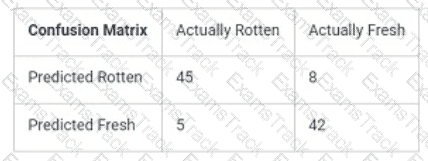Upon testing a model used to detect rotten tomatoes, the following data was observed by the test engineer, based on certain number of tomato images.

For this confusion matrix which combinations of values of accuracy, recall, and specificity respectively is CORRECT?
SELECT ONE OPTION
Which of the following descriptions of quality aspects of a data set is correct?
Choose ONE option (1 out of 4)
“BioSearch” is creating an Al model used for predicting cancer occurrence via examining X-Ray images. The accuracy of the model in isolation has been found to be good. However, the users of the model started complaining of the poor quality of results, especially inability to detect real cancer cases, when put to practice in the diagnosis lab, leading to stopping of the usage of the model.
A testing expert was called in to find the deficiencies in the test planning which led to the above scenario.
Which ONE of the following options would you expect to MOST likely be the reason to be discovered by the test expert?
SELECT ONE OPTION
Which ONE of the following activities is MOST relevant when addressing the scenario where you have more than the required amount of data available for the training?
SELECT ONE OPTION
Which statement about using AI to analyze reported defects is MOST correct?
Choose ONE option (1 out of 4)
Which ONE of the following tests is LEAST likely to be performed during the ML model testing phase?
SELECT ONE OPTION
Which of the following is an example of an input change where it would be expected that the AI system should be able to adapt?
Consider a machine learning model where the model is attempting to predict if a patient is at risk for stroke. The model collects information on each patient regarding their blood pressure, red blood cell count, smoking status, history of heart disease, cholesterol level, and demographics. Then, using a decision tree the model predicts whether or not the associated patient is likely to have a stroke in the near future. Once the model is created using a training dataset, it is used to predict a stroke in 80 additional patients. The table below shows a confusion matrix on whether or not the model made a correct or incorrect prediction.

The testers have calculated what they believe to be an appropriate functional performance metric for the model. They calculated a value of 0.6667.
Which metric did the testers calculate?
In a certain coffee producing region of Colombia, there have been some severe weather storms, resulting in massive losses in production. This caused a massive drop in stock price of coffee.
Which ONE of the following types of testing SHOULD be performed for a machine learning model for stock-price prediction to detect influence of such phenomenon as above on price of coffee stock.
SELECT ONE OPTION
Which of the following is a technique used in machine learning?
|
PDF + Testing Engine
|
|---|
|
$49.5 |
|
Testing Engine
|
|---|
|
$37.5 |
|
PDF (Q&A)
|
|---|
|
$31.5 |
ISTQB Free Exams |
|---|

|